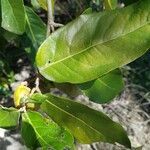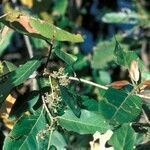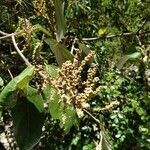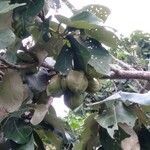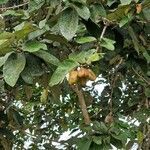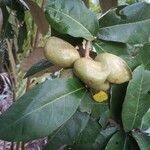Leaf-lamina c. 9–30 × 4–15 cm., very coriaceous, elliptic to ovate-or elliptic-oblong, apex acute or subobtuse, margin entire or undulate, base rounded or subcordate, green and glabrous above, with silvery scales covering the under surface and with scattered brown scales among them; petiole up to 2 cm. long, lepidote; stipules 5–6 mm. long, very caducous, lanceolate-subulate, lepidote.
Male flowers: calyx 5–6 mm. long, campanulate, tomentose, divided to about 1/3 of the way into 5 ovate acute lobes; androphore c. 1 mm. long, dilated at the base and surrounded by a minutely glandular cushion-like disk, with an apical ring of 5 anthers in a single series; vestigial style produced a little way through the centre of the ring.
Female flowers; as in the male but slightly larger and with 5 carpels connate into a broadly ovoid glabrous ovary tapering gradually to the styles, surrounded at the base by 5 free rudimentary stamens; styles 0·5–1 mm. long, connate; stigmas recurved.
Flowers yellowish-green, in much-branched stellate-tomentose panicles c. 5 cm. long in the axils of the upper leaves; pedicels up to 5 mm. long, articulated below the calyx; bracts and bracteoles up to 2 mm. long, ovate, acute, tomentose.
Ripe carpels 1–4, 6–8 × 3–4 cm., brown and shining, oblong-ovoid, strongly keeled along one side, 1-seeded.
Evergreen tree up to c. 16 m. tall; young branches lepidote, but soon glabrescent.
Seeds c. 3 × 2 × 1 cm., flattened, oblong-ellipsoid, brown.
